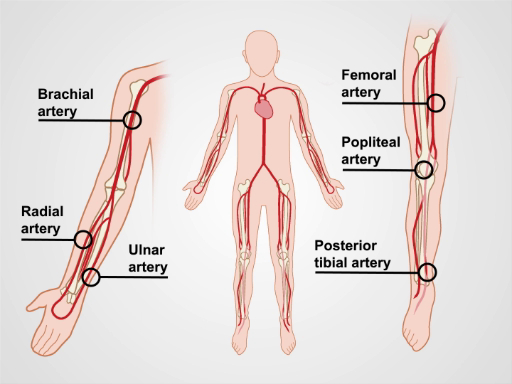Periphere vaskuläre Untersuchung
Überblick
Quelle: Joseph Donroe, MD, Innere Medizin und Pädiatrie, Yale School of Medicine, New Haven, CT
Die Prävalenz der peripheren Gefäßerkrankungen (PVD) steigt mit dem Alter und ist eine wesentliche Ursache für Morbidität bei älteren Patienten und peripheren Arterienkrankheit (PAD) ist mit Herz-Kreislauf- und zerebrovaskuläre Komplikationen assoziiert. Diabetes, Hyperlipidämie, Hypertonie und Tabak sind wichtige Risikofaktoren. Wenn Patienten symptomatisch werden, beklagen sie häufig von Gliedmaßen intermittens, definiert als ein krampfartigen Muskelschmerzen, die verschlechtert sich mit Aktivität und verbessert mit Rest. Patienten mit chronisch venösen Insuffizienz (CVI) mit unteren Extremität Schwellung, Schmerzen, Hautveränderungen und Ulzeration oft präsent.
Während die Vorteile von asymptomatischen Patienten für PVD screening unklar sind, sollten Ärzte die ordnungsgemäße Prüfung Technik wissen, wann die Diagnose der PVD-Beschichtung in Betracht gezogen wird. Dieses Video-Rezension die vaskuläre Prüfung der oberen und unteren Extremitäten und Bauch. Wie immer, eine systematische Methode zur Prüfung der Prüfer verwenden sollten, hängt aber in der Praxis, der Umfang der Prüfung, die ein Arzt führt ihren Verdacht auf zugrunde liegende PVD. Bei einem Patienten, der hat oder steht im Verdacht, Risikofaktoren für Gefäßerkrankungen haben, sollte die vaskuläre Prüfung gründlich, beginnend mit Inspektion, Palpation und Auskultation, folgten und es sollten besondere Manöver, wie die Bestimmung des Ankle brachial Indexes enthalten. Manöver, die ein handheld Doppler nutzen werden in einem Begleiter video demonstriert.

Abbildung 1. Arm und Bein Hauptarterien.
Verfahren
1. Vorbereitung
- Waschen Sie Ihre Hände vor der Prüfung des Patienten.
- Lassen Sie den Patienten ein Kleid anziehen. Diese Untersuchung sollte nie durch Kleidung auftreten.
- Überprüfen Sie den Blutdruck in beide Arme.
(2) der oberen Extremitäten
- Haben Sie die Patienten liegen, die Rückenlage auf dem Untersuchungstisch mit dem Kopf angehoben, um eine bequeme Position.
- Beginnen Sie mit einer Inspektion durch die Aufdeckung der Gesamtheit
Anwendung und Zusammenfassung
Periphere arterielle Verschlusskrankheit ist eine wichtige Ursache für Morbidität, insbesondere bei älteren Patienten. Die Erkennung und Nachbehandlung der PVD-Beschichtung können zur Verbesserung der Lebensqualität und potenziell kardiovaskuläre und zerebrovaskuläre Komplikationen mildern. Allgemeine Screening für periphere arterielle Verschlusskrankheit der Extremitäten ist keine aktuelle Empfehlung durch die uns vorbeugende Service Task Force (USPSTF). Die USPSTF empfiehlt jedoch Ultraschall-Screening für ab...
pringen zu...
Videos aus dieser Sammlung:

Now Playing
Periphere vaskuläre Untersuchung
Physical Examinations I
68.1K Ansichten

Allgemeines Vorgehen: Die körperliche Untersuchung
Physical Examinations I
116.1K Ansichten

Beobachtung und Inspektion
Physical Examinations I
93.4K Ansichten

Abtasten
Physical Examinations I
82.9K Ansichten

Perkussion
Physical Examinations I
100.0K Ansichten

Auskultation
Physical Examinations I
60.6K Ansichten

Richtiges Anpassen der Patientenkleidung während der körperlichen Untersuchung
Physical Examinations I
83.3K Ansichten

Messung des Blutdrucks
Physical Examinations I
107.6K Ansichten

Messung der Vitalzeichen
Physical Examinations I
114.1K Ansichten

Untersuchung der Atemwege I: Inspektion und Palpation
Physical Examinations I
156.9K Ansichten

Untersuchung der Atemwege I: Perkussion und Auskultation
Physical Examinations I
212.4K Ansichten

Kardiologische Untersuchung I: Inspektion und Palpation
Physical Examinations I
176.1K Ansichten

Kardiologische Untersuchung II: Auskultation
Physical Examinations I
139.6K Ansichten

Kardiologische Untersuchung III: Abnormale Herztöne
Physical Examinations I
91.6K Ansichten

Periphere Gefäßuntersuchung mit der Continuous-Wave (CW-) Dopplersonographie
Physical Examinations I
38.5K Ansichten
Copyright © 2025 MyJoVE Corporation. Alle Rechte vorbehalten